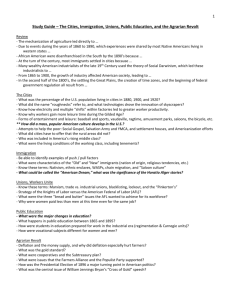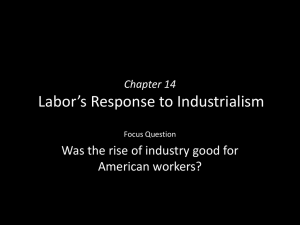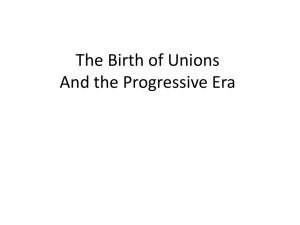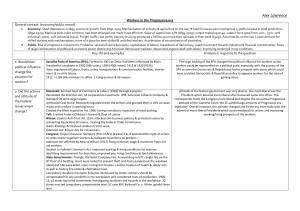Daily Comment & Card JANE ADDAMS 1860-1935
advertisement
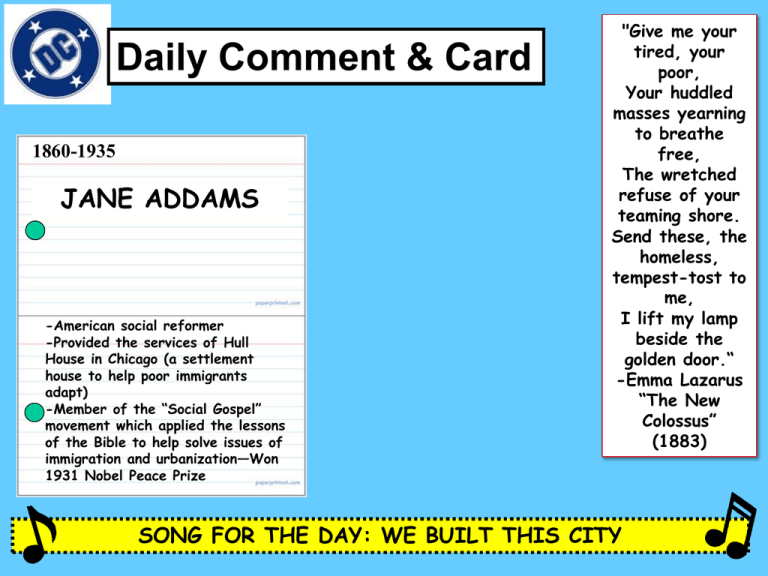
Daily Comment & Card 1860-1935 JANE ADDAMS -American social reformer -Provided the services of Hull House in Chicago (a settlement house to help poor immigrants adapt) -Member of the “Social Gospel” movement which applied the lessons of the Bible to help solve issues of immigration and urbanization—Won 1931 Nobel Peace Prize "Give me your tired, your poor, Your huddled masses yearning to breathe free, The wretched refuse of your teaming shore. Send these, the homeless, tempest-tost to me, I lift my lamp beside the golden door.“ -Emma Lazarus “The New Colossus” (1883) SONG FOR THE DAY: WE BUILT THIS CITY Daily Comment & Card 1886 AMERICAN FEDERATION OF LABOR -National craft unions representing workers in wages, hours, & safety -Individuals were members of their local unions, which then made them members of the AFL -They sought a better working life; their philosophy was “pure and simple unionism”—not trying to be revolutionary -Samuel Gompers was 1st president SONG FOR THE DAY: "Give me your tired, your poor, Your huddled masses yearning to breathe free, The wretched refuse of your teaming shore. Send these, the homeless, tempest-tost to me, I lift my lamp beside the golden door.“ -Emma Lazarus “The New Colossus” (1883) Daily Comment & Card 1860-1935 1886 JANE ADDAMS -American social reformer -Provided the services of Hull House in Chicago (a settlement house to help poor immigrants adapt) -Member of the “Social Gospel” movement which applied the lessons of the Bible to help solve issues of immigration and urbanization—Won 1931 Nobel Peace Prize AMERICAN FEDERATION OF LABOR -National craft unions representing workers in wages, hours, & safety -Individuals were members of their local unions, which then made them members of the AFL -They sought a better working life; their philosophy was “pure and simple unionism”—not trying to be revolutionary -Samuel Gompers was 1st president "Give me your tired, your poor, Your huddled masses yearning to breathe free, The wretched refuse of your teaming shore. Send these, the homeless, tempest-tost to me, I lift my lamp beside the golden door.“ -Emma Lazarus “The New Colossus” (1883) SONG FOR THE DAY: WE BUILT THIS CITY THE GILDED AGE A. WHAT WAS IT? B. ROBBER BARONS OR CAPTAINS OF INDUSTRY? 1. THE MEN 2. THE PHILOSOPHIES 3. CONSOLIDATING 4. INVENTIONS & TECHNOLOGY C. LABOR FIGHTS BACK 1. FORMING UNIONS 2. VIOLENCE D. THE BOSS SYSTEM Mark Twain was the first to use the term “Gilded Age” in 1873. It referred to the superficial glitter of the new wealth at the end of the 19th century… It was a period of weak presidents, a change in immigration, the development of industry and urban areas 2. INDUSTRIAL GIANTS Leaders of large, efficient corporations, often used questionable business practices…Monopolies led to demands for government regulation… ROBBER BARONS OR CAPTAINS OF INDUSTRY? -ANDREW CARNEGIE -JP MORGAN -JOHN D. ROCKEFELLER -VANDERBILT FAMILY THE GOSPEL OF WEALTH PROMOTED THE IDEA OF THE PROTESTANT WORK ETHIC. IT SAID THAT HARD WORK AND SUCCESS WERE SIGNS OF GOD’S FAVOR. THE WEALTHY WERE TO HELP THE POOR… Carnegie supported this idea and donated more than $350 million to libraries, schools, peace initiatives, and the arts during his lifetime… SOCIAL DARWINISM WAS BASED ON CHARLES DARWIN’S THEORY OF EVOLUTION (SURVIVAL OF THE FITTEST). THE IDEA WAS BASICALLY THAT WHEN WEALTH WAS CONCENTRATED IN THE HANDS OF THE “FIT” THAT THEY WOULD HELP THE POOR AND DO WHAT WAS BEST FOR THE REST. BIG BUSINESS BEGINS TO CONSOLIDATE… Vertical integration A company controls both the production and distribution of its products (Carnegie & U.S. Steel) Horizontal integration One company gains control over the other companies that produce the same product. By the end of the 19th century, monopolies & trusts exercised a great deal of control over the American economy… THE GOVERNMENT POLICY TOWARD BUSINESS WAS “HANDS OFF” OR “LAISSEZ-FAIRE.” THIS MEANT THEY PRETTY MUCH LEFT BUSINESS ALONE TO DO THEIR OWN THING… Consequences of Consolidation: -FACTORIES (work done by machines & unskilled workers) -TAYLORISM “scientific management” increase production & lower costs -CAPITAL (Corporations accumulated Investment $) -NATIONAL MARKETS (railroads) 3. INVENTIONS/TECHNOLOGY - SAMUEL MORSE telegraph -THOMAS EDISON Light bulb, motion picture camera, phonograph -WESTINGHOUSE & TESLA - ALEXANDER GRAHAM BELL Electric motor telephone MASS PRODUCTION ASSEMBLY PRODUCTION MARKETING ROTARY PRESS DEPT. STORES BRAND NAMES CHAIN STORES CATALOGS NEW LAWS (Gov’t begins to regulate): -PENDLETON ACT (1883) Created a Civil Service Commission which gave competitive exams and selected appointees based on merit. When the act passed, only ten percent of federal civilian employees were part of the civil service. Today ninety percent are covered by the merit system. -INTERSTATE COMMERCE ACT (1887) prohibited unfair practices by railroads, such as higher rates for shorter routes. A special regulatory commission was established to enforce the act. This was the first time that Congress stepped in to regulate business in America. -SHERMAN ANTI-TRUST ACT (1890) The purpose of this federal law was to stop monopolies engaging in unfair practices that prevented fair competition. This act marked a significant change in the attitude of Congress toward the abuses of big business. SOON WORKERS BEGAN TO ORGANIZE… KNIGHTS OF LABOR -LED BY TERENCE V. POWEDERLY -GREW RAPIDLY BECAUSE OF OPEN MEMBERSHIP POLICY (WELCOMED UNSKILLED & SEMI-SKILLED WORKERS: WOMEN, IMMIGRANTS, AND AFRICAN-AMERICANS) -BELIEVED THEY COULD ELIMINATE CONFLICT BETWEEN LABOR & MANAGEMENT. -DECLINE BECAUSE OF VIOLENCE AND BEING ASSOCIATED WITH ANARCHISTS. (BLAMED FOR HAYMARKET SQUARE RIOT) INDUSTRIAL WORKERS OF THE WORLD (IWW) “WOBBLIES” -led by “Mother” Jones, Elizabeth Flynn, and Big Bill Haywood -strove to unite all laborers including unskilled African-American labor which had been excluded from craft unions. -Goal was “One Big Union” -embraced class conflict and endorsed violence -collapsed during World War I AMERICAN FEDERATION OF LABOR (AFL) -LED BY SAMUEL GOMPERS (LEADER OF CIGAR MAKERS UNION) -AFL WAS AN ALLIANCE OF SKILLED WORKERS IN CRAFT UNIONS -AFL CONCENTRATED ON ISSUES SUCH AS HIGHER WAGES, SHORTER HOURS, AND BETTER WORKING CONDITIONS AS LABOR BEGAN TO ORGANIZE AND STRIKES BECAME COMMON…THE MOVEMENT BECAME ASSOCIATED WITH VIOLENCE! -President Hayes calls out federal troops in the RAILROAD STRIKE OF 1877 -HAYMARKET BOMBING (Union blamed for violence and deaths—Knights of Labor) -HOMESTEAD STRIKE(1892) Carnegie steel crushes workers who strike with Pinkertons -PULLMAN STRIKE (1894) During a depression, the company cut wages (kept rent and prices of goods for 12,000 workers) It stopped a lot of railroad business and ended when President Cleveland sent in federal troops. IT IS IMPORTANT TO UNDERSTAND THE SIMIILARITIES AND DIFFERENCES OF THE KofL, IWW, & AFL. ALL THREE WERE DEDICATED TO ORGANIZING LABORERS. THE KofL STROVE FOR A COOPERATIVE SOCIETY, WHILE THE IWW EMBRACED CLASS CONFLICT AND VIOLENCE. THE AFL ORGANIZED SKILLED WORKERS, AVOIDED VIOLENCE AND FOUGHT FOR HIGHER WAGES AND BETTER CONDITIONS. 3. BOSS SYSTEM DEVELOPS IN CITIES Took ADVANTAGE OF THE IMMIGRANTS who tended to settle in ethnic neighborhoods… Political parties in major cities came under the control of organized groups of politicians known as “machines”. This was known as the BOSS SYSTEM Boss Tweed of Tammany Hall was the most famous… GREEDY AS WELL AS GENEROUS, THESE POLITICAL BOSSES BOTH USED AND SERVED THE NEW POOR INNER-CITY POPULATIONS… DID DO SOME GOOD: SEWER LINES, WATER, BUILT PARKS, PLAYGROUNDS, PAVED STREETS, PUBLIC FACILITIES A LOT DONE WITH “DONATIONS”-BUT WHAT WAS EXPECTED? (VOTES, LOYALTY) FAR AND AWAY Boston Harbor (Chapter 4) (Landing in America) Chicken Factory (58:14)
